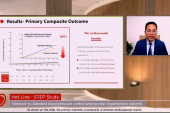SPRINT Turns Sluggish: Mortality Benefits Vanish Once Normal BP Care Resumes
Outside of the strict protocols of an RCT, keeping to a BP target of < 120 mm Hg is hard for patients and physicians alike.

Despite the impressive reductions in adverse cardiovascular events with intensive blood pressure-lowering in the landmark SPRINT study, the treatment effect, at least when it comes to mortality, is erased once patients return to real-world clinical practice, according to a new secondary analysis.
Looking at the long-term legacy effects of treatment, investigators report that the reduction in cardiovascular mortality with intensive BP-lowering was significantly attenuated in the years following SPRINT’s completion, as was the decrease in all-cause mortality.
“To keep accruing the benefits of lower blood pressure goals, you have to keep doing it,” senior researcher Nicholas Pajewski, PhD (Wake Forest University School of Medicine, Winston-Salem, NC), told TCTMD. “Over time, particularly with the cardiovascular mortality benefit, there really doesn’t seem to be much difference between the groups. Now, that doesn’t mean that blood pressure-lowering was bad or harmful—you may have delayed mortality in these patients—but by 2 or 3 years after the intervention, it really looks like the two treatment groups are similar in terms of cardiovascular mortality.”
These new data also paint a sobering, if not disappointing picture of what happened to BP once the trial was completed. From the trial’s completion to the end of extended follow-up, systolic BP increased by an average of 7 mm Hg for participants initially randomized to the intensive-treatment arm.
To keep accruing the benefits of lower blood pressure goals, you have to keep doing it. Nicholas Pajewski
Hypertension expert Naomi Fisher, MD (Brigham and Women’s Hospital, Boston, MA), said that physicians have known for decades that reducing high BP reduces the risk of major adverse events but these new data highlight what happens when patients stop taking their medications.
“Patients get put back into the real world and in the real world, blood pressure is controlled poorly,” Fisher told TCTMD. “I didn’t necessarily think that having been involved in a trial would have motivated physicians and patients to maintain such excellent control. It would have been nice, but it really turns out that there isn’t any legacy effect from having been in the SPRINT trial, as intensive and as positive as it was.”
After SPRINT finished, patients had to fill their prescriptions, collect them from the pharmacy, and pay for them, noted Fisher, adding that there are data showing that at 1 year only half of patients with hypertension adhere to medical therapy as prescribed.
“It’s a really sobering but real statistic,” she said. “Patients just don’t take their medications.”
Landmark NIH-Funded SPRINT Trial
SPRINT, published nearly 7 years ago in the New England Journal of Medicine, was a landmark National Institutes of Health-funded study that demonstrated the value of lowering systolic BP to a more aggressive target. In the trial, which included 9,361 patients randomized at 102 sites, lowering systolic blood pressure to a target less than 120 mm Hg versus the more conventional target of less than 140 mm Hg reduced the risk of MI, ACS, stroke, acute decompensated heart failure, or cardiovascular death by 25%. Additionally, treating to the lower target was associated with 34% and 27% lower risks of cardiovascular and all-cause mortality, respectively.
The STEP trial, which included more than 8,500 hypertensive patients, later confirmed the benefits of treating to lower BP targets, in that case to a goal ranging from 110 to less than 130 mm Hg. Both SPRINT and STEP were stopped early and the median follow-up in both trials was 3.3 years. Stopping a trial early, said Pajewski, leaves a lingering question as to what happened to patients once the trial was halted.
In this new SPRINT secondary analysis, the total median follow-up time was 8.8 years. The hazard ratio for all-cause mortality during the trial period was 0.83 (95% CI 0.68-1.01) favoring intensive BP-lowering but 1.08 (95% 0.94-1.23) during the observational phase. Similarly, the hazard ratios for cardiovascular mortality were 0.66 (95% CI 0.49-0.89) and 1.02 (05% CI 0.84-1.24) during the study and observational periods, respectively. The hazard ratios during the study phase differ slightly from the SPRINT trial, as there is some overlap between the study and observational phases for the trial population when time was measured relative to randomization, say investigators.
In a subset of 2,944 patients with measurements extracted from electronic health records, estimated mean systolic BP increased in the intensive arm from 132.8 mm Hg at 5 years after randomization to 140.4 mm Hg at 10 years. In those treated to the standard target, systolic BP increased from 138.8 mm Hg at 5 years to 140.2 mm Hg at 10 years. The mean between-group difference in BP shrank from 5.9 mm Hg to -0.21 mm Hg between 5 and 10 years.
It really turns out that there isn’t any legacy effect from having been in the SPRINT trial, as intensive and as positive as it was. Naomi Fisher
Investigators had hoped the data would reveal no significant differences in cardiovascular or all-cause mortality between the treatment groups—as the data did in fact show—but only because patients in standard-treatment arm would be treated to the more aggressive BP goal set out in SPRINT.
“If they were converging upon the same lower blood pressure goal, that would be great,” said Pajewski. “You’d expect the [mortality] effect to go away. That’s not what we’re seeing.”
Fisher emphasized that treating high blood pressure is a difficult, time-intensive task, both for patients and providers. Hypertension is a chronic disease and is almost always asymptomatic, which removes a major stimulus for patient motivation. While lifestyle changes are very effective at lowering BP, most patients will require medication. Nonetheless, Fisher believes that if everybody buys in—the healthcare system, provider, and patient—it’s reasonable to expect that the vast majority of patients could control their BP.
“I think 130/80 [mm Hg] is a target we could expect to hit rather comfortably in about 85% of patients,” he said. “Some healthcare systems have even reported 90% success rates.”
From an RCT to Clinical Practice
In an editorial, Daniel W. Jones, MD, Donald Clark III, and Michael E. Hall, MD (all from University of Mississippi Medical Center, Jackson), highlight the different settings between a carefully controlled trial and clinical practice. SPRINT patients in the intensive arm were seen monthly until their BP reached below 120 mm Hg and then every 3 months, with additional visits scheduled for managing adverse effects or medication changes. In all, they were seen six times a year after they’d gotten to target.
“The SPRINT protocol clearly demonstrates that a focus on proper measurement, clinician inertia, and patient adherence are key to achieving intensive BP goals,” they write. “However, this degree of intensive BP management may not seem feasible for many busy primary care practices already faced with significant challenges across a broad range of quality indicators.”
To TCTMD, Pajewski said that under the current model of care, it’s extremely difficult, if not impossible, to get patients to a target of less than 120 mm Hg. The American College of Cardiology/American Heart Association guidelines presently define stage 1 hypertension as BP 130/80 mm Hg or higher.
“In our own health system, we’d be happy if more of our hypertensive patients were just controlled below 140 mg Hg rather than talking about an even lower goal,” said Pajewski. “With all that said, there are models—groups like Kaiser [Permanente]—that have come up with ways to do this more successfully. They’re just not as prolific across the country we would like.”
One solution, he added, may be to make treatment more “protocolized.” With a trial like SPRINT, where physicians adhered to a formal treatment plan, a lot of reluctance was removed by having a protocol in place. “It’s not something we typically do in the real world, where there is more individual decision making and provider inertia around being more aggressive with blood pressure control.”
Another option to improve greater adherence to lower targets might be the creation of dedicated hypertension clinics where BP control is “off-loaded” from the primary care physician. Alternatively, it’s also possible that pharmacists might play a larger role. “The expectation that we’re going to ‘shame’ primary care providers into just doing better with this is not realistic,” said Pajewski.
Fisher agreed, saying that the traditional model of office-based hypertension care is largely a failure, and that professional societies, government agencies, and healthcare and provider groups are implementing new models of care. She remains excited about innovative new ways of treating patients, noting that renal denervation has emerged as an effective and durable therapy, one that doesn’t depend on patient adherence.
At the Mass General Brigham integrated health system, Fisher and colleagues have developed a hypertension management program with remote monitoring and an evidence-based clinical algorithm to guide treatment. The program relies on patient navigators to help and follow-up with patients and to ensure continuous contact with the healthcare system. These types of programs can be scaled up and are one way to help manage the more than one hundred million Americans with hypertension, not all of whom are able to access intensive, specialist care, she said.
Michael O’Riordan is the Managing Editor for TCTMD. He completed his undergraduate degrees at Queen’s University in Kingston, ON, and…
Read Full BioSources
Jaeger BC, Bress AP, Bundy JD, et al. Longer-term all-cause and cardiovascular mortality with intensive blood pressure control: a secondary analysis of a randomized clinical trial. JAMA Cardiol. 2022;Epub ahead of print.
Jones DW, III Clark D, Hall ME. Blood pressure control after SPRINT—back to reality. JAMA Cardiol. 2022;Epub ahead of print.
Disclosures
- Pajewski reports research support from the James B. Duke Endowment and Alzheimer’s Association.
- Fisher reports grant/research support and/or honoraria from ReCor Medical, Aktiia, and Medtronic.





Comments